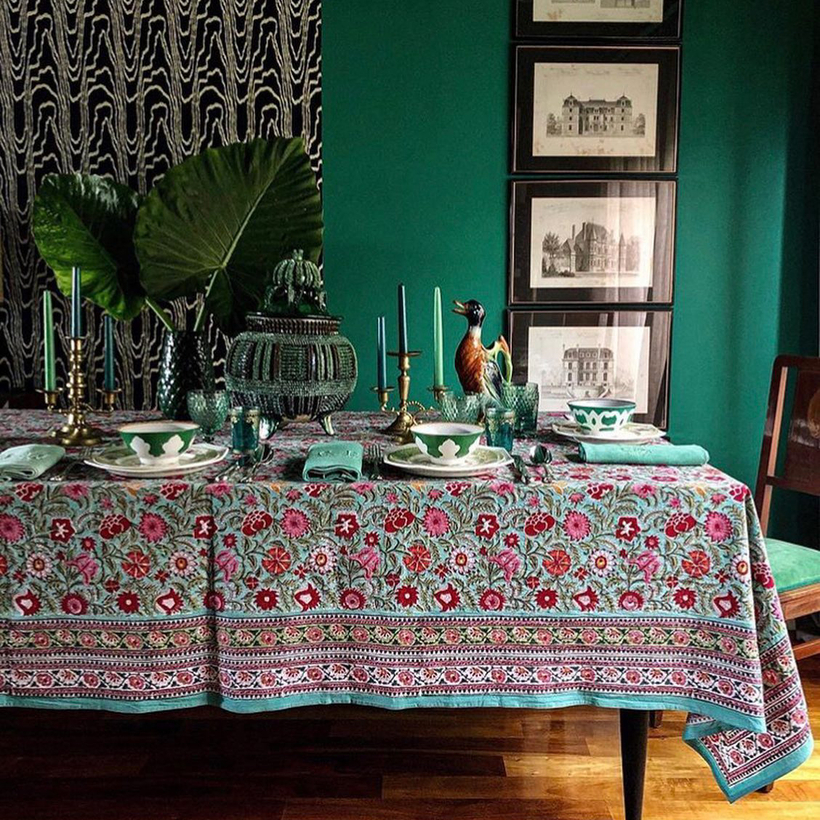The name Simrane is inspired by a Sanskrit meditation chant meant to be pronounced with lingering, worshipful syllables.
Today, however, 50 years after Frenchman Paul Comar founded the so-named brand of Indian block-print textiles, “Simrane” is uttered with equal reverence from the lips of design cognoscenti from Paris to Park Slope.
Pre-dating the Western boom of appropriating Indian block-print textiles, Simrane set a trend for the traditional Rajasthani craft in Comar’s native France. It would go on to be used with abandon by companies ranging from Williams-Sonoma to William Wayne.

“When my father started 50 years ago, block printing was not even niche; it was about to disappear,” explains Hadrien Comar, Paul’s son, who took over the business five years ago. “Now there are more printers, more craftspeople. [Our] project was to promote the craft. It doesn’t belong to Simrane—it belongs to anyone who wants to take part in the process.”
In 1970, a 30-year-old Paul Comar was working for Total gasoline in Nairobi when his then wife convinced him to take an extended trip to India. There Comar marveled at the local craftsmanship, particularly the carved Sheesham-wood-block printing.
He met a British-Indian couple, John and Faith Singh, and together they decided to begin a line of textiles. “It was the complete opposite values, working for a large corporation in the oil business,” explains Hadrien of his father’s shift in sensibilities. The Singhs soon renamed their line Anokhi, and Comar opened his first store, in Puerto Banús, in Marbella, Spain, in 1970.
The twin boutiques on the Rue Bonaparte in the heart of Saint-Germain-des-Prés followed 10 years later and earned loyal fans, including Catherine Deneuve, Jane Birkin, and Léa Seydoux. The printed linens are the main attraction, especially the vegetable-dyed Kalamkari place mats and quilted poppy-print toiletries cases.

Entering a stylish Frenchwoman’s home tends to be a quickly solved Where’s Waldo search for a Simrane tablecloth draping a fauteuil, or, as in the home of Dior Maison and Baby Dior designer Cordelia de Castellane, adorning the kitchen and bedroom.
Comar famously never signed a contract with any of the handful of family block-printing businesses he worked with in the Jaipur area. “It was always only handshakes,” explains Hadrien. “Everything started with friendship and mutual trust.”
Hadrien has continued in this tradition, journeying to Rajasthan several times a year to work with the second or third generation of the family businesses his father partnered with five decades ago.
“Simrane” is uttered with equal reverence from the lips of design cognoscenti from Paris to Park Slope.
“It’s always a dialogue between them and us,” he explains. “Different areas have different techniques and identities, and we respect that. We want to share it, not hide it. If you buy a tablecloth, you’ll see the producers names are on the label; the idea is promoting the work and the identity of the craftspeople.”

But despite multi-generational handshake partnerships, Simrane is making efforts to evolve. The company relaunched its e-commerce site a month into the coronavirus lockdowns, and they are continually surprised by the wide-reaching interest they receive via Instagram DM from clients based everywhere from New Zealand to Tokyo.
Their lead designer, Clémence Dumont, has initiated collaborations with emerging artists such as Julia Felsenthal, a Brooklyn- and Cape Cod–based painter, and illustrator Angelica Hicks.
Hadrien notes that the lifestyle shifts precipitated by the pandemic caused online sales of home goods to skyrocket, and Simrane to ramp up production accordingly. “It’s very small, what we do,” says Hadrien, who oversees a small team of three in an office behind the store in Saint-Germain-des-Prés.
When his father began the business, Hadrien notes, “he was betting on something that was not obvious at all. Now the challenge is that so many people are doing this.… They go to Jaipur and copy what you see in the local market or copy our prints. We have to stay ahead of the trends. We cannot afford to fall asleep!”
Unless you’re sleeping under a Simrane hand-printed paisley cotton quilt. Then it’s not so bad.
Chloe Malle is a New York–based writer


